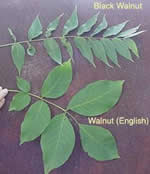Q. My question is, can pine needles be used to mulch rhubarb? I’ve heard that rhubarb and walnut trees don’t mix, but would pine needles hurt rhubarb? I’m afraid to let anyone put bark mulch around my rhubarb because the companies providing the bark do not know if there is walnut in the mix. – M.S.
A. Pine needles should be fine to use around rhubarb, a 2-3 inch layer would do nicely. Stick with fallen needles gathered from your own or local pines; there have been problems with fire ants hitching rides in pine straw from Southern states.
Black walnut trees produce a substance called juglone in all parts of the walnut, but especially in the roots, foliage buds and fruit husks. Juglone is toxic to some plants, including rhubarb, so it is best to avoid using any part of walnut in your mulch or compost. Other trees closely related to black walnut also produce juglone, including butternut, English walnut, pecan, shagbark hickory and bitternut hickory, but in such limited quantities compared to black walnut that toxicity to other plants is rarely observed. For more information on black walnut toxicity, see Purdue Extension Bulletin HO-193 “Black Walnut Toxicity.”
Q. What can I apply to string bean and escarole plants that will deter rabbits from eating them? Also, Japanese beetles ravage the leaves on the fruit trees I have. I have used malthion in the past. Could you recommend something else? Is there anything new to try? – JM, Valparaiso, Ind
A. While there are some commercially available rabbit repellents, they are of limited use in a vegetable garden. What makes the vegetables taste bad to rabbits will also make them unpalatable for humans. The most practical method of deterring rabbits is to fence the garden or at least the crops that are being damaged. The fence will need to be of woven wire or 2-inch poultry netting, 2 1/2-3 feet high to exclude rabbits. The fence should be in place at planting time as young plants are the most attractive and most susceptible to damage. More information on preventing rabbit damage to garden and landscape plan ts can be found at thePurdue Wildlife Conflicts website.
Fruit trees are among the most preferred foods of Japanese beetles, so it is a perennial battle. Adult beetles are most active from mid July through August and can quickly ravage foliage and ripening fruit, when beetles are present in large numbers. They can feed upon more than 300 different species of plants, but are especially fond of roses, grapes, smartweed, soybeans, corn silks, flowers of all kinds, and flowering crab, plum and linden trees, as well as overripe and decaying fruit. There are a number of strategies that can be employed to help reduce the damage. Check out Purdue Extension Bulletin E-75 “Japanese Beetles in the Urban Landscape,” for more information.


